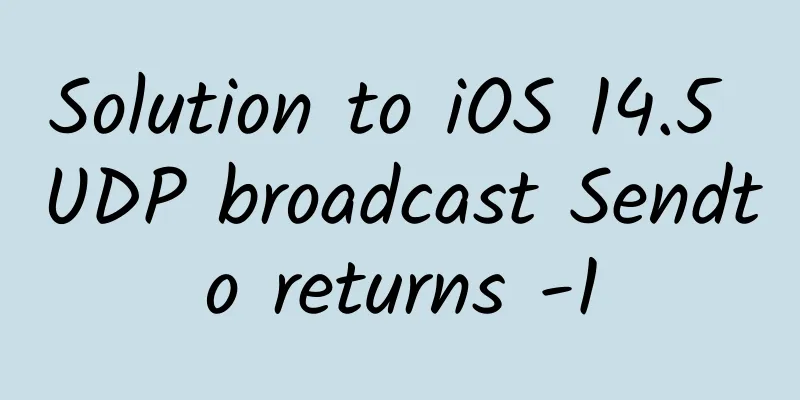Solution to iOS 14.5 UDP broadcast Sendto returns -1

|
This article is reprinted from the WeChat public account "Wangluo Development", written by Zhan Fei. Please contact the WeChat public account "Wangluo Development" to reprint this article. 1. Problem Background
The specific contents of the error are as follows:
2. Problem Analysis2.1 Troubleshooting sendto returns -1 We know that sending a broadcast sendto returns -1, and normally the sendto return value is greater than 0. First determine whether the socket connection is established
self._sck_fd4 prints:
The socket connection is normal, and then determine the data packet
Data sending failed 2.2 Add NSLocalNetworkUsageDescription permission
Found that the problem still exists 2.3 Troubleshooting unicast messages Since the hostName set for sending broadcast in the project is 255.255.255.255, in order to troubleshoot, we decided to send unicast first to see if it can succeed. After changing the unicast address to 192.168.0.101, it was found that it could be sent successfully. Then, sending unicast in the new version of CocoaAsyncSocket library was also successful. It is recommended to use 192.168.0.255 for UDP broadcast. After changing the broadcast address, the problem is solved and the device can receive UDP broadcast data. 3. Problem SolvingSince the 192.168.0.255 broadcast address is only the current local address, the first three segments of the 192.168.0 local address need to be changed dynamically in the App. The solution is as follows:
For packet filtering, you only need to filter whether the last segment of the address is 255.
|
<<: Hongmeng OS, Android, IOS, which one is the future?
>>: Android 12 is officially released: the biggest design change in Android history, smoother!
Recommend
Divergence or coexistence? A detailed explanation of Android kernel security
1. Knowledge Background In October 2003, Andy Rub...
Five key points of the new media operation matrix!
The concept of "private domain traffic"...
A strange abbreviation has appeared! Is "TMD" actually a disease?
Review expert: Lu Binshen, Department of Oral and...
Eight "traps" to avoid in the programmer profession
[[229123]] Let's face it. Some of you got int...
How to effectively deliver short video information flow?
This article mainly introduces the preparations b...
What are the benefits of adding Baidu framework users to the public?
Friends who have opened an account know that Baid...
Introduction to Xiaomi MiMeng advertising resources
Introduction to Mimeng Advertising Resources MiMe...
China Automobile Dealers Association: The auto dealer inventory warning index was 60.5% in November 2020
On November 30, 2020, the latest issue of the &qu...
Thinking Upgrade-How to Upgrade Thinking Model to Pursue Compound Interest Life
Thinking Upgrade - How to Upgrade Thinking Models...
Analysis of Xiaohongshu promotion cases
As a marketer of Xiaohongshu, why should I talk a...
E-commerce operations: coupon product analysis
On e-commerce platforms, issuing coupons is a ver...
First launched in the Chinese market, the new Audi Q8 road test spy photos exposed
According to overseas media reports, low-camoufla...
How to use sample code to access encryption and decryption and technical solutions
How to use sample code to access encryption and d...
11 fragments of observations and thoughts about B station
Bilibili has been around for 11 years. As a senio...









